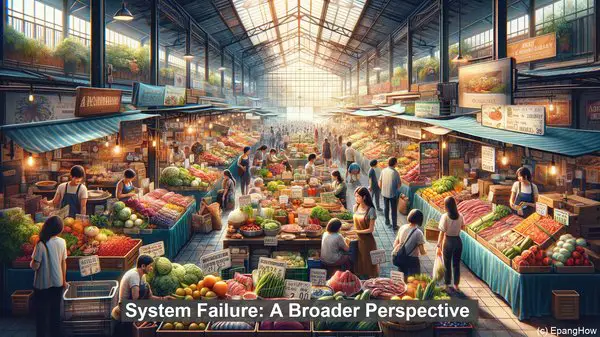Introduction: The Intricacies of Economic Dynamics
Hello, everyone! The realm of economics is a complex web of interconnections. Today, we’ll be exploring two crucial concepts that often arise in discussions about economic systems: market failure and system failure. While they may seem similar at first glance, they have distinct characteristics and implications. Let’s dive in!
Market Failure: When the Invisible Hand Stumbles
Market failure occurs when the allocation of goods and services by a free market is inefficient. In an ideal scenario, the market, guided by the ‘invisible hand’ of supply and demand, should lead to optimal outcomes. However, various factors can disrupt this equilibrium. For instance, externalities, such as pollution, can impose costs on society that are not accounted for by the market. This can result in overproduction or underproduction of goods, leading to suboptimal resource allocation.
Types of Market Failures: A Multifaceted Landscape
Market failures can manifest in different forms. One common type is the presence of public goods, which are non-excludable and non-rivalrous. Since individuals can’t be excluded from enjoying these goods, there’s a risk of underproduction due to the free-rider problem. Another type is monopolies, where a single entity controls the market, leading to reduced competition and potentially higher prices. Information asymmetry, where one party has more information than the other, can also result in market failures, as seen in the case of lemons in the used car market.
System Failure: A Broader Perspective
While market failure focuses on inefficiencies within the market mechanism, system failure takes a more holistic view. It refers to the breakdown or dysfunction of an entire economic or social system. System failures often stem from deep-rooted structural issues. For example, a financial crisis can be seen as a system failure, where multiple interconnected factors, such as excessive risk-taking and inadequate regulation, contribute to the collapse of the financial system. System failures can have far-reaching consequences, impacting not just the economy but also society as a whole.

Interplay between Market and System Failures
Market and system failures are not mutually exclusive; in fact, they can be interconnected. Market failures, if left unaddressed, can accumulate and eventually contribute to system failures. For instance, a series of market failures in the healthcare sector, such as high drug prices and unequal access, can lead to a systemic healthcare crisis. On the other hand, system failures can also give rise to market failures. In the aftermath of a natural disaster, for example, the disruption of infrastructure and supply chains can result in market inefficiencies, with essential goods becoming scarce or overpriced.
Addressing Failures: Policy Interventions and Reforms
Both market and system failures necessitate interventions to restore equilibrium. In the case of market failures, governments can employ various policy tools. For example, to address externalities, they can impose taxes or subsidies. In the case of system failures, comprehensive reforms may be required. This can involve regulatory changes, institutional restructuring, or even changes in societal norms. The key is to identify the root causes and implement targeted measures.

